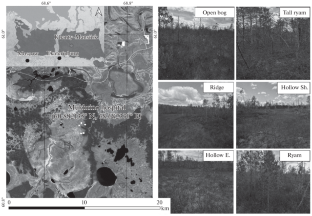Eurasian Soil Science ( IF 1.4 ) Pub Date : 2024-04-16 , DOI: 10.1134/s1064229323603232 A. V. Niyazova , D. V. Ilyasov , M. V. Glagolev , I. V. Kupriianova , A. A. Kaverin , A. F. Sabrekov , T. A. Novikova , A. V. Kaverina , I. V. Filippov , E. D. Lapshina

|
Abstract—
The response of soil respiration (Rsoil) to drought was studied for six typical oligotrophic mire biotopes in the middle taiga of Western Siberia: hollows with a dominance of Eriophorum vaginatum (hollow E) and Scheuchzeria palustris (hollow Sh), sphagnum bog with sparse low pine trees (open bog), and forested oligotrophic bogs (ryams) covered with dwarf shrub–pine–sphagnum vegetation (tall ryam and ryam). For this purpose, a regression model linking Rsoil with the level of bog water was constructed. Cumulative soil respiration (Rsoil(cum)) was measured in June–August 2021 and 2022. In the dry summer of 2022, Rsoil(cum) values increased from waterlogged (hollow E) to better drained (tall ryam and ryam) biotopes and comprised 135 ± 2.3, 139 ± 2.4, 275 ± 7.8, 279 ± 7.5, 466 ± 16.4, 510 ± 18.5 g C/(m2 season) for the considered sequence, respectively (mean ± standard deviation). An extremely low precipitation in July 2022 (6 mm) led to a sharp decrease in the water table level in August and an increase in the thickness of aerated zone with a corresponding increase in soil respiration. The Rsoil(cum) values in summer 2022 were 29 to 54% higher than those in the same period in 2021. The most active growth of Rsoil with a decrease in the water table level was observed at the periphery of the mire massif (tall ryam, ryam, and open bog biotopes) in contrast to its central parts.
中文翻译:

以典型西西伯利亚中针叶林沼泽为例的短期干旱下的土壤呼吸
摘要-
研究了西西伯利亚中部针叶林中六个典型贫营养泥沼生境的土壤呼吸( R土壤)对干旱的响应:以Eriophorum vaginatum(空心 E)和Scheuchzeria palustris (空心 Sh)为主的空洞,以稀疏的泥炭藓沼泽为对象的土壤呼吸(R 土壤)对干旱的响应。低矮的松树(开阔的沼泽)和覆盖有矮灌木、松树、泥炭藓植被(高的 ryam 和 ryam)的森林贫营养沼泽(ryam)。为此,构建了将R土壤与沼泽水位联系起来的回归模型。 2021 年 6 月至 8 月和 2022 年测量了累积土壤呼吸(R土壤(cum))。在 2022 年干燥的夏季,R土壤(cum)值从淹水(空心 E)到排水更好(高 ryam 和 ryam)生境增加对于所考虑的序列,分别为 135 ± 2.3、139 ± 2.4、275 ± 7.8、279 ± 7.5、466 ± 16.4、510 ± 18.5 g C/(m 2季节)(平均值±标准差)。 2022年7月的极低降水量(6毫米)导致8月地下水位急剧下降,通气带厚度增加,土壤呼吸相应增加。 2022年夏季的R土壤(cum)值比2021年同期高出29%至54%。随着地下水位下降,在泥沼地块的外围观察到R土壤的生长最活跃(高大的瑞姆、瑞姆和开放的沼泽生境)与其中心部分形成鲜明对比。



























 京公网安备 11010802027423号
京公网安备 11010802027423号